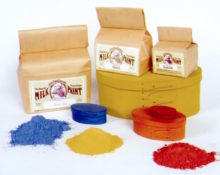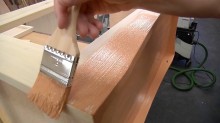Introduction to Milk Paint
Video - October 18, 2014
 Few finishes have the built-in sense of history as milk paint. Made from milk protein, pigment, and lime, this type of paint dates back to pre-recorded history. It smells like mud and doesn’t feel anything like the modern latex paints most of us are familiar with today. That said, it actually provides a fairly durable finish and when topcoated, it’s just as good as any other painting method you might come up with.
Few finishes have the built-in sense of history as milk paint. Made from milk protein, pigment, and lime, this type of paint dates back to pre-recorded history. It smells like mud and doesn’t feel anything like the modern latex paints most of us are familiar with today. That said, it actually provides a fairly durable finish and when topcoated, it’s just as good as any other painting method you might come up with.
Since many folks are looking for “greener” topcoats, milk paint serves as a very reasonable option. It’s environmentally friendly, all natural, and non-toxic. In fact, you could make your own in your kitchen if you felt so inclined.
 The Pumpkin-colored milk paint I’m using is from the Old Fashioned Milk Paint Company. In this video, you’ll see us using the product for the first time and while there’s a little more to it than latex paint, the learning curve isn’t steep. Just follow the instructions and you’ll be fine.
The Pumpkin-colored milk paint I’m using is from the Old Fashioned Milk Paint Company. In this video, you’ll see us using the product for the first time and while there’s a little more to it than latex paint, the learning curve isn’t steep. Just follow the instructions and you’ll be fine.
One of the big surprise you should be prepared for is how ugly the paint looks after the first coat. It usually takes a few coats to build up a good solid color. The paint dries to a nice matte finish and if you want more protection and a bit more lustre, topcoat with a nice water-based polyurethane. I recommend matte or satin to help keep it looking like milk paint.
Also note that depending on the substrate you use, you might need to use an additional product called Extra Bond. Simply add it to the first coat of paint to ensure proper bonding to less-porous materials.
This video is an excerpt from a the Multi-Function Toy Chest project.



